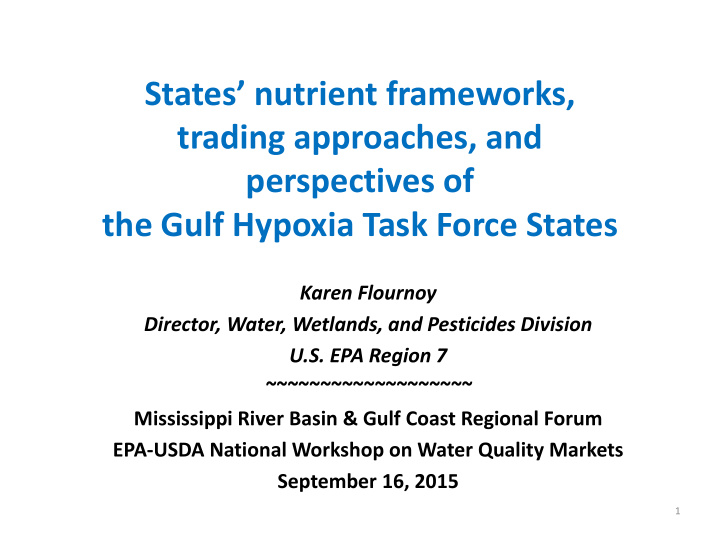



States’ nutrient frameworks, trading approaches, and perspectives of the Gulf Hypoxia Task Force States Karen Flournoy Director, Water, Wetlands, and Pesticides Division U.S. EPA Region 7 ~~~~~~~~~~~~~~~~~~~ Mississippi River Basin & Gulf Coast Regional Forum EPA ‐ USDA National Workshop on Water Quality Markets September 16, 2015 1
Nutrient Framework Elements 1. Prioritize watersheds on a statewide basis for nutrient loading reductions 2. Set watershed load reduction goals based upon best available information 3. Ensure effectiveness of point source permits 4. Control agricultural runoff 5. Control stormwater runoff and nutrients from septic systems 6. Implement accountability and verification measures 7. Report annually on implementation activities 8. Biannual report on load reductions and environmental impacts in targeted watersheds 9. Develop work plan and schedule for numeric criteria development 2
Framework: Guiding Principles • Results, results, results : build from existing state work but accelerate progress and demonstrate clear results • States need flexibility to achieve near ‐ term reductions in N and P pollution while they make progress on their long term strategies Encourage a collaborative approach between federal partners, states, and stakeholders 3
Key to success: Working in priority watersheds: HTF Progress to Date All twelve HTF states have • developed and/or released draft or final strategies HTF focus over the past 4 • years is strategy development Focus is now on • implementation ‐‐ on the ground in state priority watersheds Partnerships and • collaboration are key to strong progress Developed Jan 15, 2015 4
States referencing trading activity Arkansas Includes the phrase: “Explore the feasibility and viability of nutrient trading programs.” Illinois Illinois EPA plans to promote trading, urban/rural partnerships, or • other offsets as part of watershed planning and implementation efforts May use such trading when considering NPDES permits after an • appropriate, enforceable, and transparent program has been developed. DuPage River Salt Creek Workgroup action: evaluate the potential • for a watershed ‐ scale total phosphorus trading program. 5
Indiana Indiana envisions that the codification of numeric nutrient criteria • will be a driving force for water quality trading between point sources and agricultural producers Indiana is one of three states (OH, KY, IL) participating in the • Electrical Power Research Institute’s pilot program for the Ohio River Iowa Look for opportunities to include existing state and federal targeted • stewardship incentive programs with nutrient trading and innovative new approaches. Recognizes credit trading as helpful where it is more economical for • nonpoint source e ff orts versus point source controls. Iowa point sources plan to work to develop an environmental credit • trading program based on need and available resources, including nonpoint sources. 6
Kentucky One of three states (OH, KY, IL) participating in the Electrical Power • Research Institute’s pilot program for the Ohio River The purpose of the pilot is to evaluate the feasibility of intrastate • and interstate water quality trading, to refine the credit generation and transaction process prior to a future regulatory compliance scenario Louisiana Have conducted preliminary evaluation of water quality credit • trading. Interested in exploring other incentive avenues such as through • water quality credit trading and through business forces. Trading is a market ‐ based tool that connects different sources of pollutants to achieve a cost ‐ effective solution to water quality improvement. 7
Minnesota Currently, as an approach for Phosphorus point source to nonpoint • source is listed as low priority, but elsewhere trading said to be worth exploring Within wastewater strategy trading seen as an example of a market ‐ • based strategy Viability of an interstate nitrogen trading network said to be worth • considering. Mississippi Under “Incentives” mentions alternative approaches for creating • incentives such as Ecosystem services, Carbon credits, Nutrient trading 8
Missouri The Missouri Innovative Nutrient Trading (MINT) Project continued • a literature review of nutrient trading and conservation marketing programs and initiatives throughout the United States. In June 2011, a draft framework for a Missouri Water Quality • Trading Program was submitted to the department for review. Nutrient Trading: Missouri proposes to develop all the tools, • protocols and documentation required to support nutrient trading to establish at least a pilot trading system in the next five years. 9
Ohio Ohio EPA intends to phase in water quality based effluent limits for • phosphorus derived from the TMDL/WLA calculations. This will be done over a time frame to allow point sources to explore water quality trading or other options. Lake Erie and Ohio River Basin permits in impaired waters: set limits • with trading option. To provide a regulatory framework for water quality trading, Ohio • EPA adopted rules in 2007, OAC 3745 ‐ 5. Those rules were reviewed, amended and renewed in 2012. The key point of the rules is that water quality trading must take • place under a plan approved by the Ohio EPA Director. In addition to outlining the requirements for an approvable trading plan, the rules address technical aspects of trading such as: – Prohibitions and restrictions on trading; Calculating water quality credits; Setting baselines and trading ratios; – Incorporating trades into NPDES permits; and limiting trading to avoid adverse impacts. 10
Tennessee Agricultural communities and other relevant stakeholders will be • engaged to determine potential nutrient trading opportunities. All sources will be encouraged to consider nutrient load trading with • other sources within the HUC ‐ 10 watershed. Wisconsin Wisconsin has placed a priority on integrated point source and • nonpoint source management through… Allowance of water quality trading, another point source compliance alternative. Water quality based effluent limit compliance may be achieved • through water quality trading or through implementation of a “watershed adaptive management” option plan, or trading. Adaptive management is not trading, it is a more holistic watershed – management where the point source works to achieve net WQ goals rather than end of pipe limits. Has developed a trading framework • http://dnr.wi.gov/topic/surfacewater/adaptivemanagement.html. 11
Recommend
More recommend